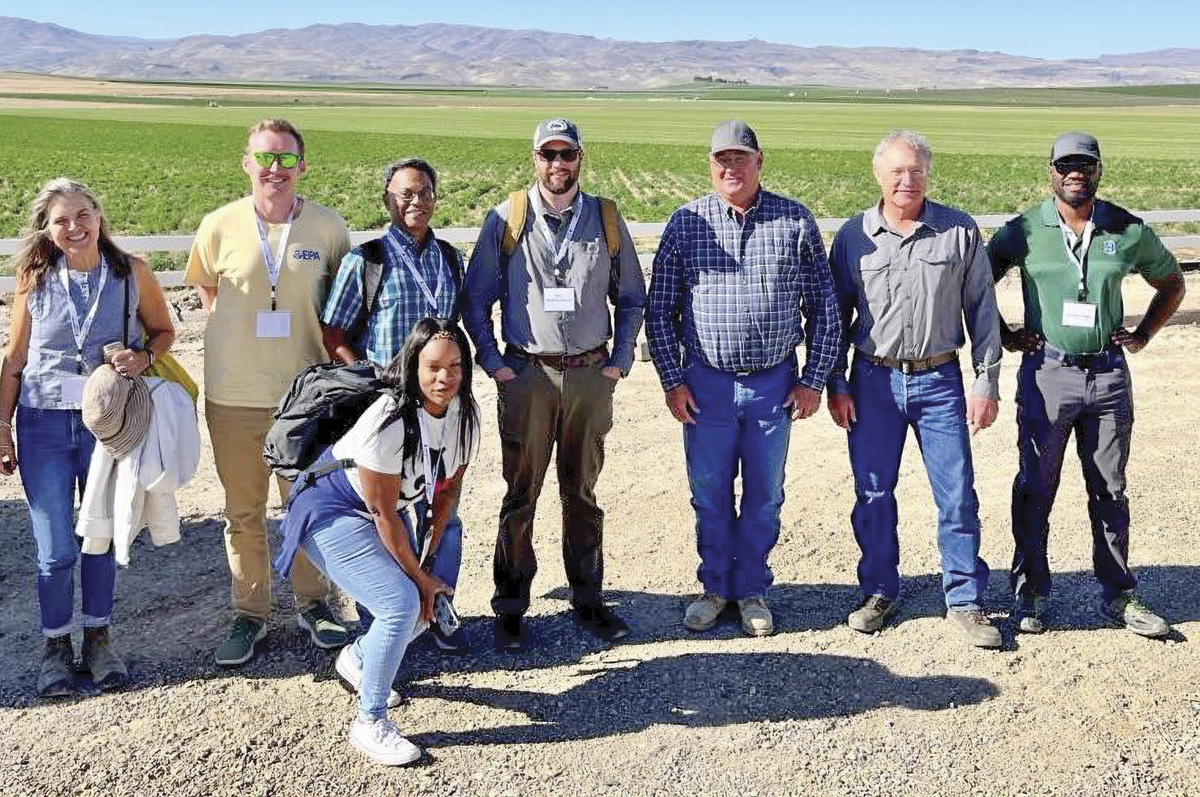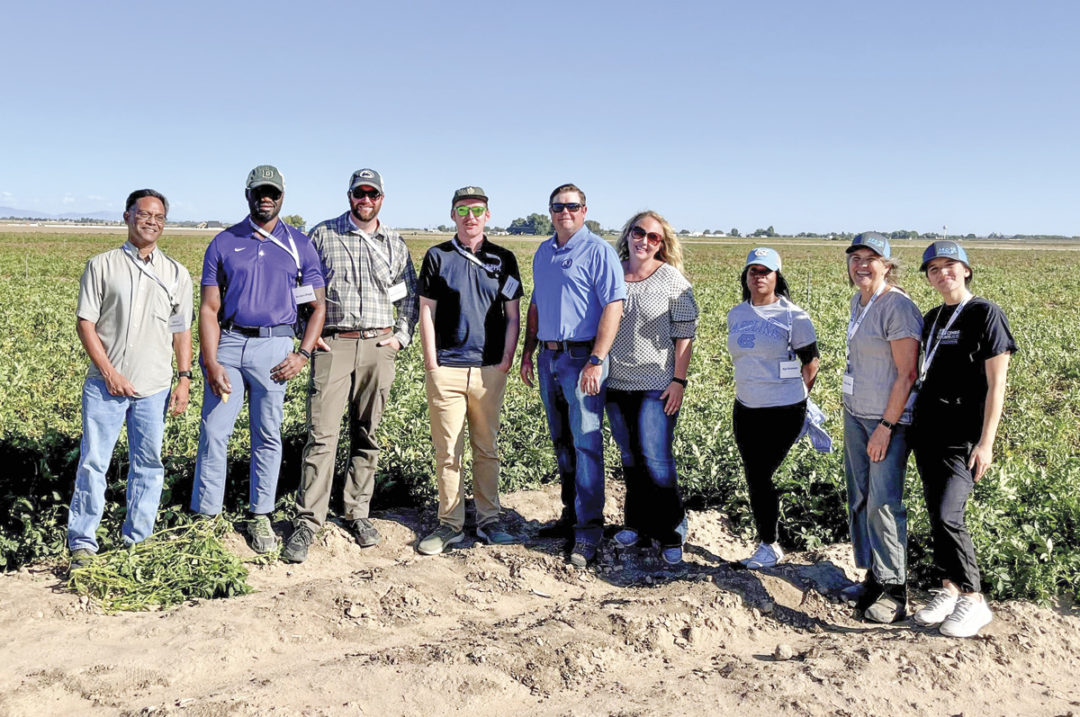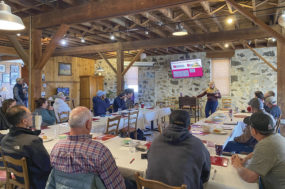“I think they get a bad rap sometimes,” says Jeff Hartman, who farms in the Parma area. “They” refers to the Environmental Protection Agency (EPA). And that’s not something you often hear about the EPA.
In September, the EPA asked for a tour of Idaho farms. Snake River Sugarbeet Growers Association (SRSGA) Executive Director Samantha Parrott put together a tour for the EPA staffers to learn from producers firsthand how their policies affect growers. Growers from several farms throughout the Treasure Valley participated to showcase production in sugarbeets, potatoes and alfalfa seed, grape vineyard operations, onion and carrot seed. Staffers were also provided an opportunity to meet with officials from the Idaho State Department of Agriculture and University of Idaho researchers at the Parma Research and Extension Center.
What EPA staffers took away from it
“They were eager to see the diversity of commodities grown in Idaho and the various irrigation practices,” Parrott says. “It was a highly engaged group of staffers who had tons of questions – a lot of really technical questions about which chemistries [the growers] were using on different crops, and I think it really surprised them as to what all goes into irrigating crops.”
Hartman is producing primarily vegetable seeds on their 1,700-acre fifth-generation family farm. They grow hybrid seed corn, certified wheat seed, fresh-pack yellow, red and white onions, alfalfa seed, carrot seed, beans for seed and silage corn. He says, “I think we showed the EPA staffers that we have a need for them to continue making these products available into the future. These chemicals, when used safely, allow us to do our job efficiently and provide the American public and the world with some of the safest, cleanest food they can get.”
Seed crops are grown by a smaller specialized group that, in the big picture of production ag around the world, is often overlooked. Seed crops are sometimes not listed on a chemical label, which makes that chemical unavailable as a resource. “We were able to help the staffers understand about seed production and the need for getting the correct verbiage ‘seed’ on the label, which is critical to us so that we can use the products that work.”
Hartman says traits in the main production crops (such as alfalfa hay, carrot and beans) also cross over into the seed side, but some chemicals aren’t currently labeled for “seed” use. “I think this could open a door for seed growers to see some future labeling on chemicals that are already being used in production crops but which are underutilized for seed because the label doesn’t specify that use,” he says. “It's not like we need a bunch of new products – there are plenty of good products on the market that are safe and can be used across multiple crops.”
The tour provided growers the opportunity to share their message with the EPA that, while it might not be their intent to take away tools from the growers’ toolbox, “[it] does happen,” Hartman says. “We encouraged them to really look at the science and the data before they start removing chemistries.”

Two ag producers who met with EPA representatives in western Idaho were Paul Rasgorshek and Leland Tiegs. Photo courtesy of Snake River Sugarbeet Growers Association.
Hartman says there were great discussions surrounding pollinators and beneficial insects, and the EPA staffers seemed somewhat surprised by the care (timing and application) that growers take to apply pesticides in such a way as to not affect the beneficial insects and pollinators, not realizing that those in the seed industry and across agriculture farms depend on beneficials and want to keep them safe and healthy.
Brodie Griffin, vice president of ag with Amalgamated Sugar Company, was also on the tour. He says, “I think they took away with them an understanding of how much we value every drop of water. Runoff risk is a major concern of the EPA and the ability of Idaho producers to utilize every drop of water via ponds, irrigation systems [drip irrigation], tailwater collection and recovery systems, or other methods, seemed to fascinate the EPA representatives.”
Griffin says, “They were also impressed with Idaho producers' attention to the timing and application of pesticides – things like spraying at night to protect pollinators, communication with neighboring producers, businesses and members of the community, and precise timing to ensure efficacy.”
What growers took away from it
“Another goal of this,” Parrott says, “was just for our growers to understand the EPA – they're just trying to do their job, and the staffers kept saying, ‘You know, we don't want to take away tools from you. That is not our intent. Our intent is to help you grow the best crop possible with the best tools possible, while still protecting people and the environment.’ And so that was an important thing for our growers in Idaho to hear as well.”
Griffin says, “Our biggest takeaway was that we, as a sugarbeet industry and other agricultural industries in Idaho, and they, as a government agency, are both working towards a similar goal – to protect our planet and those who occupy it for the future. Although we may go about solving the issues from differing points of view, deriving our facts and opinions from varying mediums, we have much in common.”
Some misunderstandings were also cleared up. “One important message the sugarbeet industry was able to share is that the loss of Lorsban (with the active ingredient chlorpyrifos) has put sugarbeet growers at a disadvantage,” Parrott says. “Growers felt like it was removed without the EPA acknowledging their own and other scientific data and without a proper sunset date. This is currently tied up in the courts, but the EPA staffers informed us they hadn’t been involved in that ban – that it came out of a lawsuit and they had no control over that. They expressed that they wanted the courts to let them do their job and test things, rather than just have courts ban them. I think that was a really good message for the producers to hear.”
Producers should know the EPA representatives asked a lot of great questions and were open to understanding the “farmer’s point of view,” Griffin says. They wanted to ensure their policies and requirements reflected the current agricultural landscape and could be implemented effectively by producers.
“We sort of always think of EPA as the enemy, and we should look at them as a partner,” Parrott says. “The stance of the sugarbeet industry, in terms of Congress, is actually that we need more funding for EPA because that's what's going to help us get chemistries approved. If you cut funding, then you cut the departments that approve chemistries that actually help our farmers put more tools in the toolbox, and the last thing we want is for a delay in that process.”




.jpg?t=1687979285&width=640)



